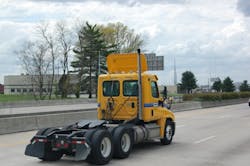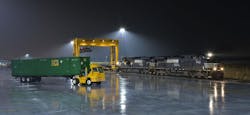For starters, Ferrell believes there’s going to be increased usage of dedicated contract carriage truck capacity as well intermodal offerings in the near future for a single reason: they both serve as a “hedge” against tightening truckload capacity; a growing issue touched on in a separate news story you’ll find today on the Fleet Owner website.
He said two things suggest that 2014 might, in fact, be the year for the oft-reduced capacity shortfall: trucking productivity losses of 1% to 3% due to hours of service (HOS) reforms made in July last year plus an economy that continues to grow, albeit slowly.
“If the economy starts posting consistent growth at a time when carriers’ expenses are increasing and drivers’ pay is decreasing, capacity will disappear quickly and shippers could be caught off guard,” Ferrell warned. “If the next prediction comes true, the capacity issue will be exacerbated further.”
Research by Tompkins indicates that dedicated fleets represented the fastest growing sector of the truckload market last year, even though they only account for about $40 billion of a $280 billion industry.
“It is a sector that is growing for all the right reasons,” Ferrell pointed out. “For shippers, it secures capacity, locks in a competitive cost, increases service, and reduces volatility, without having to invest in assets or deal with the headaches of managing drivers. For carriers, it smoothes out cyclicality, fosters a long-term relationship with a client, and allows them to provide more drivers with the highly desirable regular route that tends to be both more predictable and closer to home.”
He also thinks we’ll begin to see more small carriers heading for the trucking industry exits in 2014, in part due to HOS reform as well as other factors.“What are bigger threats to smaller carriers versus larger carriers? The lower cost and ease of entry into cutting edge technology, the expansion of private fleet and intermodal, and the lost revenue stemming from the recently implemented HOS law,” Ferrell noted. “These are all bigger threats to smaller carriers. Additionally, larger carriers are typically less reliant on profit-siphoning freight brokers, have access to newer, more fuel efficient fleets, and enjoy greater economies of scale. And now with the Affordable Care Act [known more widely as ‘Obamacare’] set to go into full effect, the cost of driver benefits is about to go up.”
“All of these issues point to the likelihood of smaller carriers hanging a ‘for sale’ sign on the door this year; or simply shutting the windows altogether,” he said. “The longer the economy draws out its choppy comeback, the more at-risk small carriers will be. While the old saying suggests that ‘trucks never go out of business, they just change color,’ that does not mean the industry is impervious to short-term disruptions caused by consolidation.”
Those trends will help reinforce what Tompkins views as an ongoing shift to intermodal as a truckload alternative “in record numbers.”
According to the Association of American Railroads, the numbers for 2013 were up by 4.6% over the previous year, and the total containers shipped surpassed the previous pre-recession high of 2006 by over half a million units, Ferrell noted.
Why? First, the growth of intermodal in recent years has caused the railroads to place increased emphasis on service, in-transit visibility, and timeliness of both arrival times and container availability. This provides shippers with the predictability and confidence to incorporate the longer lead-time in order to take advantage of the 15% to 25% savings that the mode typically offers when compared to truckload.
Second, increased interest from the “demand side” of the intermodal equation – from shippers – is rising and more transportation management systems (TMS) offer more consistent shipping, visibility, and rates for intermodal.Third, intermodal services are now being offered to more places. “One should not be surprised that the eastern and western railroads are offering more capacity and opening up new – or reopening old – terminals to expand service offerings,” Ferrell noted.
In anticipation of the now-stalled Panama Canal expansion, both the western and eastern railroads were highly motivated to expand and improve current service offerings. Though the Canal’s expansion is now in limbo, railroads still remain are poised to fill the void with expanded alternatives, increased service, and better visibility, he explained. “Combined with equally motivated shippers and carriers, intermodal’s continued growth in 2014 seems assured,” Ferrell added.
Now add in the subject of “re-shoring,” the term for bringing manufacturing back to the U.S. Results from the 2013 Tompkins Supply Chain Consortium survey on the subject suggest companies will selectively bring back manufacturing jobs to the U.S., especially in the case of high value items with unique intellectual properties.
Though such moves are expected to offer little “macroeconomic impact,” Tompkins thinks a more narrowly-focused effort on “right-shoring,” whereby just part of the manufacturing process tis relocated to achieve the lowest landed cost, is beginning to gain a “true” foothold and will continue to be an opportunity in 2014.
Then there’s the case for carriers converting portions of their fleet to run on natural gas: a shift that seems in Tompkins’ view of things to be taking a firmer hold in trucking.“Although the upfront costs are higher – i.e., natural gas engines are at least $35,000 more expensive than their diesel alternative – the case for conversion is quite compelling: the cost per gallon equivalent of natural gas is typically between $1.50 and $2.00 less than a gallon of diesel,” Ferrell said. “As of January 2014, the difference was $1.79.”
He pointed to United Parcel Service and its 2104 order for 700 natural gas-fired highway tractors, as an example; a number that represents about 12% of its over-the-road fleet. “And all this is happening during a time when less than 25% of a planned natural gas refueling network is operational,” Ferrell stressed.
Finally, Tompkins touches on an area that may ultimately up-end some of the traditional dynamics of freight movement: the convergence of more e-commerce activity with 24-hour delivery cycles offered seven days per week.
That may sound crazy to some truckers, but here’s an interesting thought: Tompkins draws a connection between those two trends and the acquisition last year of the Washington Post newspaper by Amazon founder Jeff Bezos.
What does a newspaper have to do with supply chain trends? “On a daily basis, newspapers like the Washington Post take stories, articles, and columns that did not exist in their final form until around midnight, create a finished product, and then physically deliver them to an entire city’s worth of doorsteps less than six hours later, seven days per week,” explains Ferrell.
“Whatever anyone thinks about the future of the newspaper industry in general, this is a supreme display of supply chain prowess that nobody thinks about because it all takes place while we are asleep,” he said. “Will an Amazon order placed by a consumer in the evening one day be delivered the next morning by the same truck delivering newspapers? Possibly. Will Bezos use his learnings about the newspaper’s supply chain to see what he can apply to Amazon? Almost certainly.”
Similar to newspaper delivery, Amazon also forged a partnership with a provider that is already delivering to almost every single address in the U.S. six days per week – the U.S. Postal service – that’s now also agreed to deliver on Sundays as well for Amazon. “In the current setup, that would mean an item needed for work or school could be ordered on Friday and be sitting at a customer’s doorstep before it is needed on Monday morning,” Ferrell stressed.
Yet he believes such “next-day delivery” is not where Amazon is truly headed.
“From a supply chain perspective, this is not about sending something to a customer before it is ordered; it is about reducing the amount of time between the order and the delivery,” Ferrell explained. “When Amazon first began making noise about same-day delivery, many industry experts focused on the strain this would put on carriers. It already takes half a day to get the order picked and ready for shipping at the distribution center, and even then it would only work if the origin distribution center were within a few dozen miles of the destination. It appears that Amazon is preparing itself to do that work ahead of time.”
And if traditional carriers can’t handle such “next day” demands, Amazon can simply contract with a group of people who are already driving by, if not delivering to, everyone in the U.S. already: such as the newspaper delivery van or the U.S. Postal Service.
“Individually these stories are all interesting,” Ferrell said. “When combined together they give the appearance of a full frontal assault on same-day delivery, seven days a week at minimal or no extra cost. When Amazon successfully creates this as a customer expectation and combines it with already competitive prices, traditional retailers will have to wonder why anyone would ever want to step foot in a store again.”
Something trucking companies may need to factor into their strategic planning for the future.




